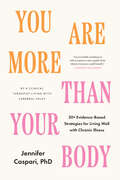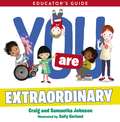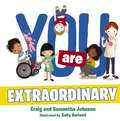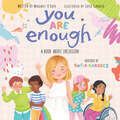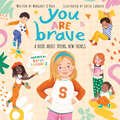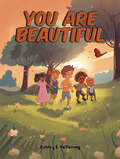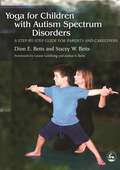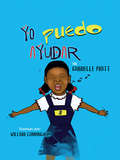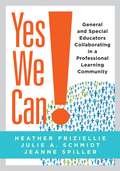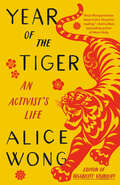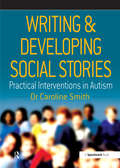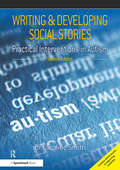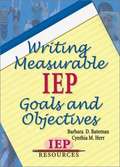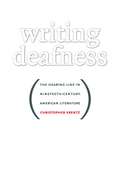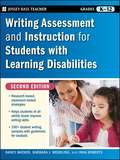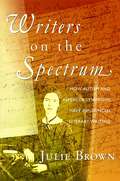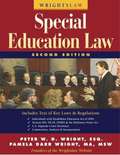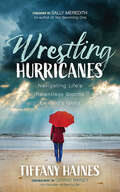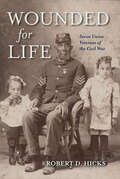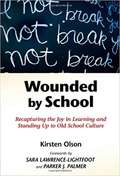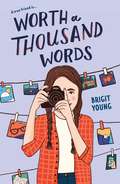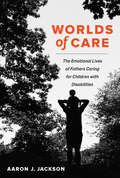- Table View
- List View
You Can Still Go to Hell, and Other Truths About Being a Helping Professional
by David MoreauFrom the back cover: Reading this collection while drinking bad coffee in a cheap motel room, I was struck by Moreau's honesty and humor These poems are irreverent, funny and provocative, raising important questions. Like, Why is no one recording staff's bowel movements? My coffee began tasting better, and I decided that everyone in the world should buy this book. Peter Leidy. Singer/Activist, author of Greetings from Human Service Land Read these poems. They pull no poetic punches, recording the skirmishes between human empathy and the institutions set up to organize it. David Moreau. with his eagle eye and his ear for the music of speech, details the clash between system and soul, fellow feeling and bureaucratic b.s. His clients may be limited in some ways, but in Moreau's fast-paced colloquial narratives, their humanity is heartbreakingly clear. And that clarity, mixed with edgy humor and affection, is cause for gratitude and hope. Betsy Sholl. Poet Laureate of Maine This is a wonderful (please buy it) collection. David Moreau doesn't waste a single word on setting or scenery, but I can tell you, I can draw a picture. This is a place for which a Holiday Inn architect phoned in the design, with each room having no egress to fresh air. This is no-exit land, but each resident has a personality and character and style. There are real people here and God bless them all. Bravo, Dave!
You Are More Than Your Body: 30+ Evidence-Based Strategies for Living Well with Chronic Illness--By a clinical therapist living with cerebral palsy
by Jennifer Caspari PhdA gentle, supportive guide to developing coping skills and improving quality of life for disabled and chronically ill peopleManaging the stresses of everyday life can be exhausting and overwhelming. Dr. Jennifer Caspari knows this struggle well—both through her work as a clinical psychologist and her lived experience as a disabled woman with cerebral palsy. You Are More Than Your Body weaves together clinical expertise, personal stories, and practical, evidence-based tools to help readers with chronic health conditions better cope with pain, fatigue, depression, and the emotional vulnerability that comes with living in a world not designed for our bodies. The methods in this book synthesize a wide range of emotional regulation skills and coping techniques drawn from cognitive behavioral therapy (CBT), acceptance and commitment therapy (ACT), and mindfulness practices, all of which Dr. Caspari has successfully used with her own clients. In this book, you&’ll learn over thirty practical coping skills to help you:tune into internal experience and connect with your body; shift mental focus;cultivate self-compassion and radical acceptance; change your relationship with your thoughts; engage the power of the present to get unstuck; practice realistic goal-setting;tap into your deepest values as a resource;tolerate discomfort; andgive yourselves permission to do things differently.Each chapter includes a personal story or experience; a self-reflection exercise; associated coping skills; and practical guidance on how you can start using these tools in your own life. Having a disability or chronic illness does not have to mean accepting a lower quality of life. While we can&’t make our issues and challenges disappear, by practicing the exercises in this book, we can learn to better manage challenges that arise and learn how we can live a meaningful life now—whatever our bodies and abilities might be.
You Are Extraordinary Educator's Guide: Educator's Guide
by Craig Johnson Samantha JohnsonYou Are Extraordinary Educator's Guide is a companion to You Are Extraordinary by Craig and Samantha Johnson. This guide can be utilized in the classroom, in a home school setting, or by parents seeking additional resources. Ideal for Kindergarten through 1st grade.
You Are Extraordinary
by Craig Johnson Samantha JohnsonIn You Are Extraordinary, Craig and Samantha Johnson use fun rhymes and colorful pictures to celebrate kids who have unique challenges and gifts. Every page in this book focuses on a different ability or diverse circumstance, such as autism, different ethnicities, unique sizes and body types, physical limitations, cancer, adoptions, and more. You Are Extraordinary is an inspiring reminder to treat others with kindness and live out the truth that you are loved! And a letter to parents at the beginning of the book will encourage parents and caregivers and remind them that they're not alone.As the parents of a child with special needs, Craig and Samantha Johnson understand that kids who are a bit different from others sometimes need extra reassurance that God has an amazing purpose for them—not just despite their differences but because of them! The authors are the founders of Champions Club, an international ministry of Lakewood Church in Houston, Texas, for kids, teens, and adults with special needs. Joel Osteen, the senior pastor of Lakewood, is one of the many well-known supporters of Champions Clubs around the country.With its fun and uplifting message, You Are Extraordinary reminds children and adults alike that the world is a beautiful place when we treat everyone as the exceptional people they are!
You Are Enough: A Book About Inclusion
by Margaret O'Hair Sofia SanchezA beautiful and inclusive picture book all about celebrating being yourself from Down syndrome advocate and viral sensation Sofia Sanchez!It can be hard to be different -- whether because of how you look, where you live, or what you can or can't do. But wouldn't it be boring if we were all the same? Being different is great! Being different is what makes you YOU.This inclusive and empowering picture book from Sofia Sanchez -- an 11-year-old model and actress with Down syndrome -- reminds readers how important it is to embrace your differences, be confident, and be proud of who you are. Imagine all of the wonderful things you can do if you don't let anyone stop you! You are enough just how you are.Sofia is unique, but her message is universal: We all belong. So each spread will feature beautiful, full-color illustrations of a full cast of kid characters with all kinds of backgrounds, experiences, and abilities.This book will also include back matter with a brief bio of Sofia and her journey so far, as well as additional information about Down syndrome and how we can all be more accepting, more inclusive, and more kind.
You Are Brave: A Book About Trying New Things
by Margaret O'Hair Sofia SanchezAn inspiring and inclusive picture book about overcoming the odds from Down syndrome advocate and viral sensation Sofia Sanchez!Just because you are different, that doesn’t mean you can’t succeed and share your gifts and passion with the world! That is the timely and important message of You Are Brave. This book helps readers learn their own self-worth and encourages kids to overcome obstacles by sticking up for themselves and others, trying new things, and showing the world how brave they are!This companion picture book to 2021’s You Are Enough and 2023’s You Are Loved focuses on dreaming big and overcoming any obstacles that stand in your way. Sofia has Down syndrome, but she hasn’t let that stop her from becoming a successful model, actress, and activist. Sofia is the perfect person to share You Are Brave's message of encouragement and bravery with kids everywhere.
You Are Beautiful
by Ashley E. KetteringYou Are Beautiful is a contemporary children&’s book that celebrates children&’s differences. This is a book that any child can pick up to read and feeling good about themselves and their friends.You Are Beautiful is a representation of many children, including those with special needs. This book highlights differences, teaches kindness, understanding and reminds us all that we are beautiful just the way we are.
Yoga for Children with Autism Spectrum Disorders: A Step-by-Step Guide for Parents and Caregivers
by Dion Betts Stacey W. BettsHaving successfully used yoga to combat the stress of their own busy lives, Dion and Stacey Betts discovered its potential for their son Joshua, who has Asperger Syndrome. This fully-illustrated book combines the authors' professional expertise with their experience of parenting, offering a range of gentle and fun yoga positions and breathing techniques that are effective in dealing with the increased levels of anxiety, disorientation and tactile sensitivity often found in children with autism spectrum disorders (ASDs). The authors give step-by-step descriptions of warming-up, strengthening, calming, and tension-releasing exercises that are suitable for reducing coping mechanisms, such as hand-flapping, and increasing muscle tone, muscle strength and body awareness. They also offer a range of short and long sequences that can be tailored to fit the needs of the individual child. Yoga for Children with Autism Spectrum Disorders is ideal for parents and caregivers who want to use simple yoga techniques to help children with ASDs overcome some of the symptoms of the disorder.
Yo Puedo Ayudar
by Gabrielle PrattDaniela va a dormir en casa de la abuela Valeria y a pasar un tiempo con la tía Sofía que está enferma de cáncer. Mientras comparte con ellas, demuestra el aprecio y amor que siente por su tía. A través de actos sencillos de bondad, muestra además una gran compasión por ella. ‘’Yo puedo ayudar’’ es una historia clásica donde la Palabra de Dios puede influenciar a los niños y a las niñas de manera creativa para iluminar la vida de una persona enferma que ellos amen mucho. ¡Es una historia que todos deben leer! Pastor Ron Shearer, Máster en Teología Iglesia Evangélica Blue Hill Nassau, Las Bahamas Con gran placer y satisfacción elogio y felicito a Gabrielle Pratt por la publicación de ‘’Yo puedo ayudar’’. Aunque el libro está enfocado a lectores jóvenes, contiene una valiosa lección que eleva el espíritu en todas las edades. Mi esperanza está en que este texto pueda enseñar a los jóvenes a tener fe en Dios y que puedan mostrar aprecio, aceptación y generosidad a otros no solo en Las Bahamas, sino también alrededor del mundo. Vera Chase Presidenta de la Mancomunidad de Escritores de Las Bahamas
Yes We Can! General and Special Educators Collaborating in a Professional Learning Community
by Heather Friziellie Julie A. Schmidt Jeanne SpillerAs states adopt more rigorous academic standards, schools must define how special education fits into standards-aligned curricula, instruction, and assessment. Utilizing PLC practices, general and special educators must develop collaborative partnerships in order to close the achievement gap and maximize learning for all. The authors encourage all educators to take collective responsibility in improving outcomes for students with special needs.
Yellow Bird and Me
by Joyce HansenDoris becomes friends with Yellow Bird as she helps him with his studies and his part in the school play and discovers that he has a problem known as dyslexia. Sequel to The gift-giver.
Year of the Tiger: An Activist's Life
by Alice WongNATIONAL BESTSELLER • ONE OF USA TODAY'S MUST-READ BOOKS • This groundbreaking memoir offers a glimpse into an activist's journey to finding and cultivating community and the continued fight for disability justice, from the founder and director of the Disability Visibility Project&“Alice Wong provides deep truths in this fun and deceptively easy read about her survival in this hectic and ableist society.&” —Selma Blair, bestselling author of Mean BabyIn Chinese culture, the tiger is deeply revered for its confidence, passion, ambition, and ferocity. That same fighting spirit resides in Alice Wong. Drawing on a collection of original essays, previously published work, conversations, graphics, photos, commissioned art by disabled and Asian American artists, and more, Alice uses her unique talent to share an impressionistic scrapbook of her life as an Asian American disabled activist, community organizer, media maker, and dreamer. From her love of food and pop culture to her unwavering commitment to dismantling systemic ableism, Alice shares her thoughts on creativity, access, power, care, the pandemic, mortality, and the future. As a self-described disabled oracle, Alice traces her origins, tells her story, and creates a space for disabled people to be in conversation with one another and the world. Filled with incisive wit, joy, and rage, Wong&’s Year of the Tiger will galvanize readers with big cat energy.
Writing and Developing Social Stories: Practical Interventions In Autism
by Caroline SmithThis practical resource provides an introduction to the theory and practice of writing social stories. In addition, there are examples of successful stories to use as guides, as well as information and photocopiable resources for delivering training on the use of social stories. Based on detailed work carried out in homes, schools and pre-schools, this book offers practical support to anyone meeting the needs of a child or young adult with an autistic spectrum disorder. Social stories are short stories intended for children with autism to help them understand their social world and behave appropriately within it. The stories provide clear, concise and accurate information about what is happening in a specific situation, outlining both why it is happening and what a typical response might be. It is written by those directly supporting a child with autism and only successful stories are included in the book. The stories are infinitely flexible and adaptable to an individual child in an individual social situation. It covers children aged 3 to 16.
Writing and Developing Social Stories Ed. 2: Practical Interventions in Autism
by Caroline SmithThis practical resource provides an introduction to the theory and practice of writing social stories. In addition, there are examples of successful stories to use as guides, as well as information and photocopiable (and downloadable) resources for delivering training on the use of social stories. Based on detailed work carried out in homes, schools and pre-schools, this book offers practical support to anyone meeting the needs of a child or young adult with an autistic spectrum disorder, and with staff supporting adults with autism. Social stories are short stories intended for children and adults with autism to help them understand their social world and behave appropriately within it. The stories: provide clear, concise and accurate information about what is happening in a specific situation, outlining both why it is happening and what a typical response might be; are written by those directly supporting children or adults with autism and only successful stories are included in the book; are infinitely flexible and adaptable to an individual child in an individual social situation. FEATURES: This 2nd edition has been thoroughly revised and updated throughout. It also now contains: brand new stories including examples for use by parents at home; brand new section on mental health; and, additional stories for use with adults with autism.
Writing Measurable IEP Goals and Objectives
by Barbara D. Bateman Cynthia M. HerrA guide to quick and effective writing of accurate and measurable IEP goals and objectives. IEPs are necessary, required by law and when done properly can be extremely helpful in guiding the student's educational trajectory. This book, written by two of the foremost special educators and IEP legal experts is designed to bring you up to speed whether you're just entering the field or have worked in it for years.
Writing Deafness
by Christopher KrentzTaking an original approach to American literature, Christopher Krentz examines nineteenth-century writing from a new angle: that of deafness, which he shows to have surprising importance in identity formation. The rise of deaf education during this period made deaf people much more visible in American society. Krentz demonstrates that deaf and hearing authors used writing to explore their similarities and differences, trying to work out the invisible boundary, analogous to Du Bois's color line, that Krentz calls the "hearing line." Writing Deafness examines previously overlooked literature by deaf authors, who turned to writing to find a voice in public discourse and to demonstrate their intelligence and humanity to the majority. Hearing authors such as James Fenimore Cooper, Lydia Huntley Sigourney, Herman Melville, and Mark Twain often subtly took on deaf-related issues, using deafness to define not just deaf others, but also themselves (as competent and rational), helping form a self-consciously hearing identity. Offering insights for theories of identity, physical difference, minority writing, race, and postcolonialism, this compelling book makes essential reading for students of American literature and culture, deaf studies, and disability studies.
Writing Assessment and Instruction for Students with Learning Disabilities
by Nancy Mather Barbara J. Wendling Rhia RobertsIt Contains strategies for working with all students that struggle with writing, Offers classroom-tested strategies, helpful information, 100+writing samples with guidelines for analysis, and handy progress-monitoring charts, Includes ideas for motivating reluctant writers, Mather is an expert in the field of learning disabilities.
Writers on the Spectrum
by Julie BrownFrom Hans Christian Andersen's fairytale characters to Lewis Carroll's Wonderland and Emily Dickinson's poetic imagery, the writings and lives of some of the world's most celebrated authors indicate signs of autism and Asperger's Syndrome. Through analysis of biographies, autobiographies, letters and diaries, Professor Julie Brown identifies literary talents who display characteristics of Autistic Spectrum Disorder (ASD) and uncovers the similarities in their writing that suggest atypical, autistic brains. Providing close readings of authors' works, Brown explores writing processes, content, theme, structure and writing style to reveal the underlying autistic traits that have influenced their writing. The book provides an overview of ASD and common threads in autistic writing followed by an illuminating exploration of how these threads are evident in the literature of both well-known and lesser known authors. This groundbreaking study of autism in literature will be of interest to anyone with a professional or personal interest in literature or the autistic mind.
Wrightslaw: Special Education Law (2nd Edition)
by Pamela Darr Wright Peter W. D. WrightWrightslaw: Special Education Law, 2nd Edition provides a clear roadmap to the laws and how to get better services for all children with disabilities. This Wrightslaw publication is an invaluable resource for parents, advocates, educators, and attorneys. You will refer to this book again and again.
Wrightslaw: From Emotions to Advocacy - The Special Education Survival Guide
by Peter Wright Pamela Darr WrightThe Special Education Survivor Guide: A Must for Parents!
Wrestling Hurricanes: Navigating Life's Relentless Storms for God's Glory
by Tiffany HainesAn honest and incredible account of one family’s journey through a medical mystery and raising kids with special needs.It is a journey that led Tiffany Haines to the answer for every one of life’s “why” questions. And, spoiler alert, the answer is simply the glory of God. For parents of atypical children, Wrestling Hurricanes speaks to the highs and lows of a chaotic life, which no one else can understand. For the Church, it provides an authentic example of how Christ followers can choose to react to life’s storms. For every person who has asked why, it provides a clear, compelling, and biblical answer. In the end, Wrestling Hurricanes can be a foundational, modern story of resilience by which small group and ministry leaders can teach not just the Gospel, but also share God’s ultimate plan for now and eternity.“A compelling story of faith, courage, and perseverance of how one woman battled her storms by following Jesus.” —Dennis Rainey, cofounder of FamilyLife“Ms. Haines writes in a way that few of her contemporaries have yet to capture. Wrestling Hurricanes enlightens the mind, inflames the heart, and engages the will. That is why it is not only a map into the peaceful eye of the hurricane but also a truly life-changing experience.” —Dr. Barry R. Leventhal, distinguished senior professor, Southern Evangelical Seminary, and Mary P. Leventhal, leader of women’s church ministries“This book will inspire, bring answers, and give renewed faith to parents of children with emotional struggles and women dealing with cancer.” —Lana Bethune, family advocate, former member of House of Representatives
Wounded for Life: Seven Union Veterans of the Civil War
by Robert D. HicksMost histories of wounded Civil War veterans construe them as feminized men whose manhood has suffered due to their inability to provide for and raise families or engage in business. Wounded for Life complicates this picture by examining how seven veterans—six soldiers and one physician—coped with their changed bodies in their postwar lives.Through these intimate stories, author Robert D. Hicks looks at the veteran's body as shaped by the trauma of the battlefield and hospital and the construction of a postwar identity in relation to that trauma. Through his research, he reveals the changing social circumstances of the late 19th and early 20th centuries as they impacted the traumatized veteran's body. This engaging book is equal parts Civil War history, disability and gender history, and the history of the body that discloses the impact of war on a wounded warrior.
Wounded by School: Recapturing the Joy in Learning and Standing Up To Old School Culture
by Kirsten OlsonWhile reformers and policymakers focus on achievement gaps, testing, and accountability, millions of students mentally and emotionally disengage from learning and many gifted teachers leave the field. Ironically, today’s schooling is damaging the single most essential component to education―the joy of learning <p><p> How do we recognize the "wounds" caused by outdated schooling policies? How do we heal them? <p><p> In her controversial new book, education writer and critic Kirsten Olson brings to light the devastating consequences of an educational approach that values conformity over creativity, flattens students’ interests, and dampens down differences among learners. Drawing on deeply emotional stories, Olson shows that current institutional structures do not produce the kinds of minds and thinking that society really needs. Instead, the system tends to shame, disable, and bore many learners. Most importantly, she presents the experiences of wounded learners who have healed and shows what teachers, parents, and students can do right now to help themselves stay healthy.
Worth a Thousand Words
by Brigit YoungWhether it’s earrings, homework, or love notes, Tillie “Lost and Found” Green and her camera can find any lost thing—until a search for a missing person forces her to step out from behind the lens. Ever since a car accident left Tillie Green with lasting painful injuries, she's hidden behind her camera. She watches her family and classmates through the lens, tracking down misplaced items and spotting the small details that tell a much bigger story than people usually see. But she isn’t prepared for class clown Jake Hausmann’s request: to find his father.In a matter of days, Tillie goes from silent observer to one half of a detective duo, searching for clues to the mystery of Jake’s dad’s disappearance. When the truth isn’t what Jake wants it to be, and the photographs start exposing people’s secrets, Tillie has to decide what—and who—is truly important to her.Worth a Thousand Words is the debut book by Brigit Young.
Worlds of Care: The Emotional Lives of Fathers Caring for Children with Disabilities (California Series in Public Anthropology #51)
by Aaron J. JacksonThe stories of fathers caring for non-verbal children and how these experiences alter their understandings of care, masculinity, and living a full life.Vulnerable narratives of fatherhood are few and far between; rarer still is an ethnography that delves into the practical and emotional realities of intensive caregiving. Grounded in the intimate everyday lives of men caring for children with major physical and intellectual disabilities, Worlds of Care undertakes an exploration of how men shape their identities in the context of caregiving. Anthropologist Aaron J. Jackson fuses ethnographic research and creative nonfiction to offer an evocative account of what is required for men to create habitable worlds and find some kind of "normal" when their circumstances are anything but. Combining stories from his fieldwork in North America with reflections on his own experience caring for his severely disabled son, Jackson argues that care has the potential to transform our understanding of who we are and how we relate to others.

